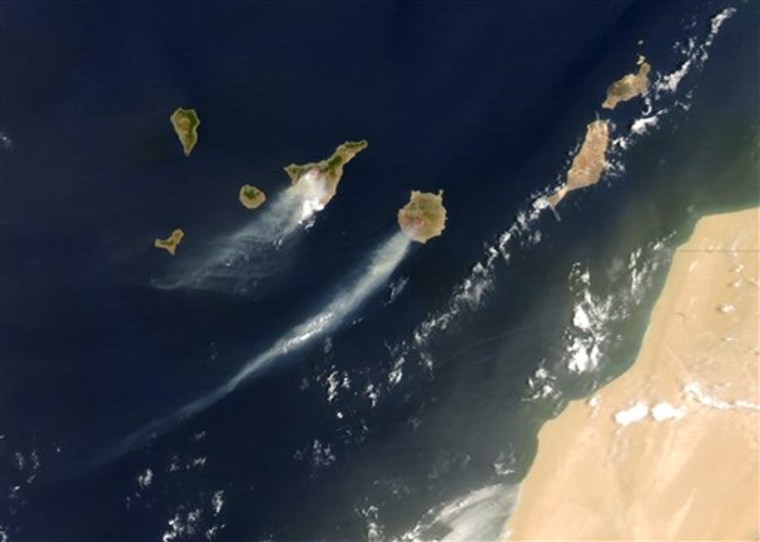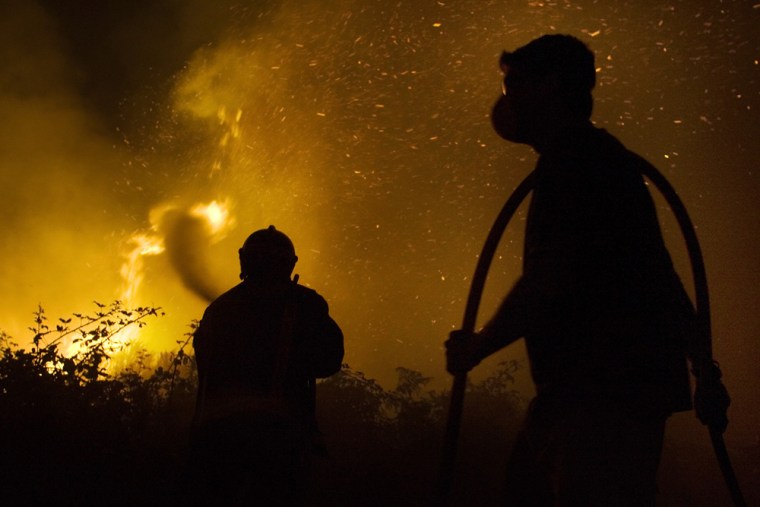Crews have managed to control two huge forest fires that forced the evacuation of 14,000 people from homes, hotels and camp grounds at one of Europe's top tourist areas, officials in Spain's Canary Islands said Wednesday.
Tourist hotspots in Tenerife and Gran Canaria escaped the devastating fires, but environmentalists said the impact on the Spanish archipelago’s unique wildlife was incalculable.
Britain’s biggest tour operator, Thomas Cook, said the fires had not affected beaches or holidaymakers. Last year, the region welcomed 9.6 million foreign visitors.
However, environmentalists said the fires could be a disaster for species that are unique to the Canaries.
The archipelago’s isolation, 80 miles off the Moroccan coast, means it is a treasure trove for biologists. Gran Canaria contains 50 percent of the species unique to Spain.
“Anything that declines these species can be absolutely catastrophic,” said Peter Jones, a biologist who advises Spain’s Environment Ministry.
Concern over rare finch
“I’m particularly worried about the blue chaffinch which is extremely rare, perhaps just a few hundred left, and which is largely confined to conifer woodlands on Tenerife,” Jones said of a native bird species.
Around a third of Gran Canaria’s forests have now been reduced to ashes, said Roberto Castro, an engineer with a foundation working to reforest the islands. “The main problem isn’t the pine trees but the vegetation underneath ... almost none will have been able to survive,” he said, adding that 10 to 15 species would probably disappear.
A disgruntled park ranger has admitted starting the fire on Gran Canaria, angry over the shortness of his contract. He has been arrested.
The second fire, on Tenerife, was also set deliberately, officials said Wednesday. No arrests have been made.
The local government of Tenerife said the fires were brought under control in the morning due in large part to an easing of winds that had gusted at up to 40 mph — and prevented water-dumping helicopters from operating on Tuesday. Crews have also been hampered by extremely hot weather and low humidity.
The blaze forced the evacuation of 8,800 people and blackened 37,000 acres of land. At least 900 homes have been destroyed.
5,200 fled on Gran Canaria
On Gran Canaria, officials said most of the fire fronts there have also been brought under control. There, the fire razed 25,000 acres of land and caused 5,200 people to be evacuated. Most of those evacuated have already started to go back to their homes.

Prime Minister Jose Luis Rodriguez Zapatero arrived here Wednesday to assess damage from the worst fires to hit the Canary Islands in 50 years.
Zapatero had been due to travel to Barcelona Wednesday but instead rushed to Tenerife. He announced an emergency cabinet meeting for Friday — the government is largely on vacation now — to approve special aid for the islands.
No one has been injured. The fires have burned inland areas rather than the coastal resorts popular with Europeans seeking sun and sand. But officials said that together, the fires on Tenerife and Gran Canaria have charred more land than any series of infernos here in 50 years.
Spanish newspapers have published satellite photos showing huge plumes of white smoke rising from the islands and footage of citizens using tree branches to slap in vain at flames approaching rural roads.
